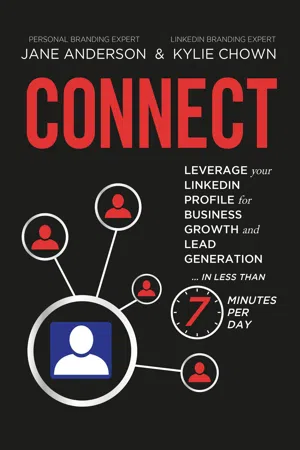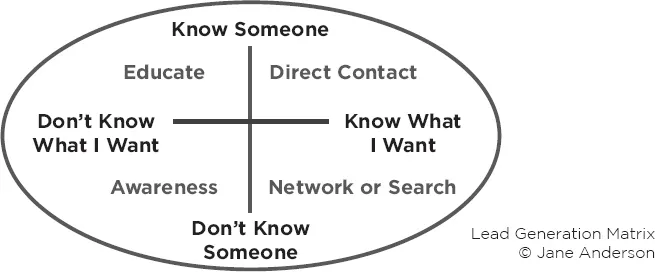![]()
Chapter 1
Why is LinkedIn So Important For You?
Reid Hoffman, the co-founder of LinkedIn, recently said: “If you can get better at your job, you should be an active member of LinkedIn, because LinkedIn should be connecting you to the information, insights and people to be more effective.”
In 2009, Jane began working with people on LinkedIn. It wasn’t that LinkedIn was new; it was that it had been reserved for executives. She was helping people get jobs after the global financial crisis, and every so often she would meet someone who needed to be on LinkedIn. They were so reluctant to get online. She tried to find someone who could write their profiles. There wasn’t anyone, so she began to write them herself.
Fast forward to 2011. Jane was on a plane next to a gentleman. She was flying between Brisbane and Canberra. She talked to the gentleman, and discovered he owned a technology company specialising in network security. He was also a professor of IT security at a university. He did a lot of consulting work in Canberra for the Australian Federal Government. Jane asked him: “Are all your team on LinkedIn? How do you use LinkedIn as part of your business?”
He said: “Actually, I’ve removed our sales team. I just have one sales manager now. I allow them to spend one day a week in forums on LinkedIn and other sites. Our technical experts answer questions and are connected to our customers. This is just how our customers want to communicate now, and our business has changed quite dramatically as a result.”
Since then, we’ve noticed that traditional sales approaches and the new ways of selling and creating leads are quite different.
Most people will ask: “Isn’t LinkedIn just like an online version of your resume?” Or: “Isn’t it like Facebook, but for business?”
A LinkedIn profile is like your own personal website for your business and for you as someone in charge of sales or business growth. We’re in the connection economy. When we’re online, we want to be able to connect.
People do their research long before they get in touch with you. A CEB study found that about 60% of a buying decision is made before the person buys from you. It’s a bit like TripAdvisor, where people do their research online before they decide to connect.
You can access people, information and misinformation more readily. If you need a financial planner and you’re in Sydney, Australia, and you want to talk to someone in New York because you have been told they’re the best, then that’s what you can do. You’re no longer restricted by location.
You can also access experts. Nowadays, if there is an expert in flamenco dancing and they are in Spain, you can go online and learn from a flamenco dancing teacher in Spain.
This is because of sites such as Elance, oDesk and Popexpert.
You might be thinking, “What does that have to do with LinkedIn?” What it means is that if you focus locally, you must have a strong presence, and LinkedIn is an effective way of achieving that.
It’s getting more difficult to access decision makers because they’re so busy. According to a study by the Radicati Group, business users sent and received on average 121 emails a day in 2014, and this is expected to grow to 140 emails a day by 2018. The amount of information landing in inboxes is extraordinary.
To cut through this noise is quite difficult, so we have to go to spaces where people hang out. Considering the average person spends two hours per day using social media, this is where we need to go to connect with them. We are in the connection economy.
The truth is we don’t even know about missed opportunities because we don’t get feedback.
Challenges with the Current Sales Process
Pigeonholing, Stereotypes and Unconscious Bias
You would have heard the saying: “first impressions last”. In fact, Margaret Thatcher once said: “I usually make a decision about a person in the first 10 seconds and I usually find that I’m right.”
There is a lot of information and misinformation out there. People want to understand who you are and where you’re coming from. Otherwise, they will stereotype you very quickly. Their perception could be based on what you have done in the past, rather than what you can offer for the future.
You need to determine what you want their interpretation of you to be, and convey yourself in that light when you connect. They may not need your help right now, but they may know someone who does.
Something to remember is that your mistakes are not as obvious online as they are in the real world and you don’t know the opportunities you’re missing. People can look at your profile and move on, and you don’t even know. There is a world of opportunity sitting at your fingertips. It’s now time to take the opportunity to help those clients who are looking for you and need your help!
Some other challenges in the current selling climate include:
•Access to decision makers: This is more difficult as gatekeepers are becoming more challenging to manage.
•“Digital First”: Increasingly customers are undertaking research online before making buying decisions. As mentioned, 60% of a buying decision is made before a customer makes contact. This means the use of Google searches are increasing. Sites such as Trip Advisor to choose hotels and Urban Spoon to choose a restaurant are examples of that.
•The high cost of doing business: Organisations are finding it increasingly challenging to meet skyrocketing overheads and wages. Businesses don’t have money to waste any more.
•Flexibility: Businesses need to be able to move fast. Customers’ needs change quickly and businesses need to be agile, yet stay on track.
•The struggle to find more ideal customers: It’s difficult for businesses to position themselves for new clients and markets.
•Time and money: A business’s growth isn’t restricted to a local area anymore. We have access to markets nationally an internationally, but it takes time and money to build those markets and have a presence in those locations.
•Unqualified leads: We don’t have time to waste on people who don’t meet your sales criteria.
•People do their research: Customers research online to find the cheapest option.
•The increasing cost of search engine optimisation and Google AdWords: It’s becoming extraordinarily expensive to get results from online advertising.
•A feeling of paralysis: With the sea of information available, combined with a lack of time and money, many businesses choose to do nothing. It can all seem too hard.
The Connection Economy
The old ways of selling have changed. It used to be about calling. It used to be about samples and then trying to get meetings with people. Now it’s quite different. Now it’s about leveraging people’s social networks. It’s about engagement, which means connecting with people, and it’s about education. We need to be able to educate people about how we can help them. This is, essentially, the social sales model.
Past | Present | Future |
Employees | Role Models | Ambassadors |
Cold Calls | Tribes | Engagement |
Sales Demonstrations | Education | Thought Leadership |
Salesperson | Trusted Adviser | Expert |
Transaction | Solution Selling | Lifetime Partnership |
According to Ipsos Open Thinking Exchange, the average person spends two hours a day on the internet. IBM’s Global CEO Study found that CEOs believe social media utilisation for customer engagement will increase by 256% over five years to become the second-most popular way to engage customers after face-to-face communication.
How You’re Found in the Marketplace
Customers find you via various means when they work with you. The following quadrants are the most common.
So, How Do People Find You?
“If I know someone and I don’t know what I want.”
If this is the case with a customer, they’re going to ask the people they know. If they’re more extroverted, they will probably go to their networks. If they’re more introverted, then they will jump online and do a Google search.
The benefit of being referred in your networks means you have a good reputation. If you’ve got a good reputation, then you’ve got good positioning.
The problem with someone doing a Google search is that they don’t know you, so you will be competing against others who have experience with search engine optimisation or Google AdWords. What it also means is that you will be like toothpaste on a supermarket shelf, looking the same as everybody else. You will compete on price, and that’s a very difficult space in which to sell.
If you are well networked, then your referrals will come to the fore and that can be more effective.
“If I know someone and I know what I want, then what I’m going to do is direct contact.”
If this is the case, the customer is going to pick up the phone and call you or email you because they already know who you are. The challenge for direct contact is that you have to be front of mind.
“For someone I don’t know and I don’t know what I want.”
In that case, your job is to educate. You have to make sure you’re putting content out there so people understand what you do and realise that they do have a particular problem. If someone has a problem, they’re not going to know unless you keep educating them. You want them read your content and think, “There, that’s exactly what I’m after.”
“I don’t know that I have a problem and I don’t know someone.”
In that case, your job is awareness. Your job is to make sure your profile is clear about how you help people, but you also must write blog ...

